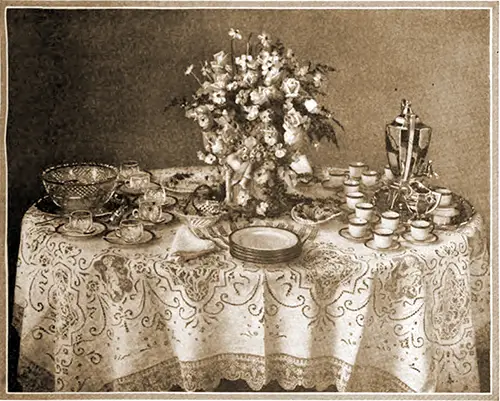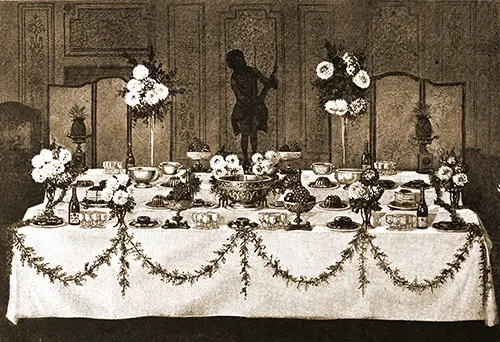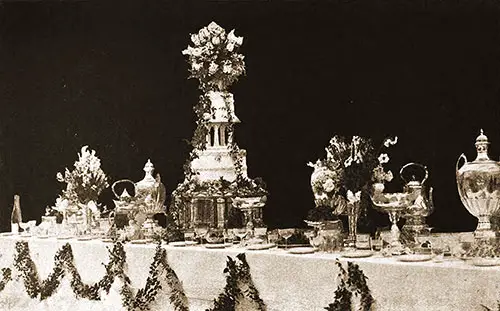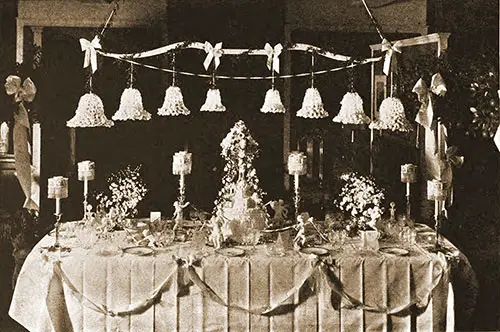Buffet Style of Serving for Brides
In the buffet style of serving breakfast, luncheon, dinner, or informal refreshments, the guests are served from a long table or buffet. Menu options are also explored.

Wedding Buffet Table Set Up with Plates, Napkins, Punch Bowl and Glasses, Coffee and Coffee Cups, with a Center Floral Piece. Suitable for a Home Receiption Setting. Good Housekeeping, June 1916. | GGA Image ID # 20302567e1
In the buffet style of serving a luncheon or informal refreshments, the guests are served from a long table or buffet, receiving portions of the dishes on plates with the appropriate forks or spoons. They return to their seats to eat. Sometimes, the refreshments are passed to the seated guests, and there is usually an attendant to collect and remove the used plates, etc.
We have seen luncheons of several courses served this way: a jellied bouillon, then a creamed meat or fish dish, or croquettes, followed by a salad, then a sweet dish and coffee. Words for buffet refreshments have to be of the kind that can quickly be eaten from the plate held in one hand with the fork or spoon in the other. Knives are not used, for the guests do not sit at tables and are not expected to make tables of their laps.
The Bridal Buffet Supper
By Ida C. Bailey-Allen
Of course, the underlying principle of the buffet meal should be eliminating work. To this end, the guests come informally to the dining room and help themselves and eat standing, either in the dining room or elsewhere; or the gentleman may go after refreshments for themselves and the ladies; or the various urns, chafing dishes, etc., may be in charge of uniformed waitresses or waiters who will do the serving, the guests waiting on themselves.
In any case, assistants must be provided to collect soiled dishes and napkins, replenish empty plates with cakes, sandwiches, etc., and see that the hot dishes supply does not give out.
The dining room should be decorated with tall, slender flower vases on the sideboards and tables. The buffet should be covered with a linen scarf, while tea cloths or heavy damask tablecloths may be used on the tables.
The napkins may be placed on the plates and piled up or kept separate. The silver is usually spread out upon the linen covers: bouillon spoons near the urn and bouillon cups, forks near the chafing dish and plates, etc. This prevents all rattling and handling of silver in selecting necessary utensils.
If the affair is small and the menu simple, it is possible to arrange everything on a dining table: the bouillon or coffee might occupy one side, hot dishes another, a cold entrée a third, and salad the remaining space; ices are usually served from the pantry.
Small dishes of candies, olives, nuts, etc., as well as plates of tiny rolls, bread sticks, and sandwiches, may be placed on the table as convenient. However, grouping the foods upon buffets and tables at extensive collations is much more satisfactory to prevent a crush in any one place.
The coffee urn or large percolator, cups and saucers, spoons, cream, and sugar may be arranged on an extra small table.
Conventionally, the first course consists of bouillon accompanied by tiny breadsticks or unbuttered rolls. If the weather is warm, an iced or jellied bouillon may be substituted for the hot dish.
The second course may consist of creamed meat or fish in timbales or puff paste cases, tiny croquettes (one-third the usual size), or a mixture of sweetbreads and mushrooms served with small rice croquettes. Sometimes deviled crabs or a Newburg constitute the hot dish, but the choice depends on the season and whether or not the dish can stand without being ruined.
At very elaborate affairs, a cold entrée, such as ham loaf, jellied chicken, chicken mousse, or a meat galantine, is served with the hot course. In that case, a salad is optional. If a mold of meat appears, it should be sliced thin before sitting on the table, being kept in the original shape if possible. It is, therefore, customary to garnish such dishes elaborately with sliced egg, parsley, pimiento stars, etc.
A light salad is in order if the hot dish is heavy; if not, a different type should be chosen. If served from a platter on the table, the salad should be arranged individually, a small portion on a crisp white lettuce leaf, to ensure easy service.
Dessert invariably consists of two or more ices molded together, such as lemon sherbet and raspberry mousse, maple walnut and pistachio ice cream, etc. In case of a great crowd, so there will be no danger of melting before being utilized, ice is sometimes unmolded upon a platter and served at the table by a maid.
Coffee is always provided, and if the weather is warm, a cold drink, served in a punch bowl, the cups beside it, should be at the guests' disposal.
Bridal Buffet Supper Menu Options
Option 1: No Hot Dishes
- Jellied Chicken Broth
- Tuna-Salad Sandwiches
- Nut Sandwiches
- Olives
- Salted Nuts
- Chocolate Frappe. Whipped Cream
- Little Cakes
- Orangeade
- Coffee
Option 2: For the Warm Days of Late Spring
- Strawberries au Naturel
- Jollied Tongue
- Buttered Baking-Powder Biscuits
- Olives
- Bonbons
- Salted Nuts
- Asparagus Salad
- Macaroon
- Ice Cream
- Angel Cake
- Iced Coffee
Option 3
- Celery Bouillon
- Bread Sticks
- lobster Newburg in Chafing Dishes
- Little Rolls
- Olives
- Salted Nuts
- Raspberry Mousse and Lemon Sherbet
- Chocolate Cakes
- Lady Fingers
- Coffee
Option 4
- Jellied Chicken Broth
- Whipped Cream
- Bread Sticks
- Crab Flake or lobster Salad
- Buttered Rolls
- Chocolate Parfait and Pistachio Ice Cream
- Decorated Pound Cakes
- Little Wafers
- Coffee
Option 5
- Creamed Oysters in Paper Cases
- Pimiento Sandwiches
- Grated Cheese Sandwiches
- Olives
- Salted Nuts
- Peach Melba (Vanilla Ice Cream. Raspberry Jam and Canned Peaches)
- Homemade Sponge Cake
- Oatmeal
- Macaroons
- Coffee
Whereas these menus may seem somewhat elaborate, it must be borne in mind that there are no cast-iron rules governing buffet meals. To this end, a hostess is correct if she serves only bouillon, sandwiches, and dessert; a hot dish, olives and nuts, lettuce sandwiches and dessert; or a salad, sandwiches, and dessert. It is far better to do this than to serve such a variety that one is tired out with the preparation.
Wedding Breakfasts

Supper Buffet Table Suitable for a Ball or Reception. The Art of the Table, 1923. | GGA Image ID # 20312bdef4
Wedding breakfasts nowadays, with a few exceptions, have much simpler functions than they were wont to have in the past. Even amongst the aristocracy, the reduction of incomes and the general rise in the cost of living have made themselves felt in various ways.
Nuptial celebrations, formerly an opportunity for lavish display, have now resolved themselves into more ethereal elements, affording scope to the artist rather than the caterer. There are three varieties of wedding breakfasts now in vogue.
The substantial meal, though seldom met with today, except in large country houses, somewhat remote from the world, still occurs occasionally. A substantial meal then takes the place of luncheon.
For guests arriving from a long distance, the dinner is sometimes served midday, before the wedding ceremony.
The following menu illustrates the kind of dishes usually served at the substantial wedding breakfast:
- Consommé en tasses
- Tranches de Saumon Mayonnaise
- Aspics de Crevettes
- Médaillons de Volaille à la Gelée
- Mousselines de Jambon à la Reine
- Œufs farcis en Surprise
- Canapés Jamaïque
- Sandwiches variés
- Gelées aux Fruits
- Suédoise Rubanée
- Méringues Chantilly à la Violette
- Macédoine de Fruits
- Pâtisseries Assorties
- Dessert
Sometimes, however, the difficulty of feeding hungry visitors from a distance, especially when the house is not sufficiently large to accommodate them for a sit-down meal, is solved by providing an early lunch for them on the train journey.
This is carried out by the caterer in charge of the wedding arrangements and is consistent with the railway routine, as the dishes are cold, and their service is provided entirely by the caterer.
An intermediate variety of wedding breakfast is also served in the country, which, though less substantial than the luncheon type's breakfast, still contains more or less robust dishes.

Table Set Up for a Wedding Receiption Buffet. The Art of the Table, 1923. | GGA Image ID # 2031477564
The following is a specimen menu of this variety:
- Bouchées aux Huîtres
- Barquettes de Homard
- Petites Bouchées de Volaille
- Croûtes Assorties
- Sandwiches
- Langue Œufs et Cresson
- Chesterfield Foie Gras
- Pain Bis Crevettes
- Gâteaux
- St. Dâmier, Napolitaine, Béatrice
- Mille Feuilles
- Biscuits aux Amandes
- Éclairs aux Chocolat
- Pâtisseries assorties
- Petits Fours
- Marrons glacés
- Bonbons
- Thé et Café. Limonade
- Macédoine de Fruits
- Dessert
Distance is not the only reason for these more substantial breakfasts, but also the fact that marriage ceremonies in country churches usually take place at an earlier hour than those in city churches. However, the most usual Wedding Breakfast nowadays is the buffet variety. This arrangement gives much scope for skill in artistic decoration.
A buffet of from about 16 to 18 feet in length is placed along the most convenient side of the dining room, the two- or three-tier wedding cake is arranged in the middle, and smaller dishes of cakes, sandwiches, fruit, ices, etc., interspersed with silver urns, and vases or trails of flowers and greenery fill in the spaces on either side.
Tea, coffee, and lemonade form the principal beverages of the buffet breakfast, with claret cups seldom seen nowadays. Champagne, sacred to wedding festivities, is served only after the bride has cut the wedding cake, usually towards the end of the breakfast.
The following breakfast menu is an example of the buffet type.
- Sandwiches
- Volaille Victoria Foie Gras Langue
- Saumon fumé
- Chesterfield
- Pain Bis
- Œufs et Cresson
- Gâteaux
- Alexandra. Normandie
- Petits Fours
- Génoise glacée
- Madeleines. Friandises
- Éclairs au Chocolat et Café
- Biscuits aux Amandes
- Marrons glacés
- Chocolats et Fondants
- Pain et Beurre
- Thé.
- Café.
- Limonade
- Café glacé
- Glaces
- Crème au Fraises.
- Crème à la Vanille
- Eau de Muscat
The prevailing note of decoration in most weddings is white and silver; the former is carried out in the flowers and napery, the latter in the silver-printed menus, vases, urns, cutlery, etc. However, a note of color is struck, especially if the bride prefers this direction.
The floral device of a recent wedding in town consisted of blue hydrangeas in the form of horseshoes, blue being the bride's favorite color. Low decoration schemes are the most popular for buffet breakfasts, as vases are prone to topple over, especially where there is any crush.

Wedding Breakfast Table, Completely Decorated. The Art of the Table, 1923. | GGA Image ID # 203152da29
As in a recent buffet decoration, a symbolic touch is always appreciated, where the wedding ring is the design motif. This design can be carried out in small flowers. As space is valuable on a buffet, these flower rings can be placed around the base of dishes of the epergne type.
The rings may be made up of moss and wire and protected underneath with silver paper, a break left in each circle so that it can be slipped around the front of the dish and joined.
The base of the cake can be encircled in the same way. An attractive finish is provided by suspending over the cake's top through silver cords and tassels, a small hoop with flowers embedded in moss, and a cluster of silver tissue bells in the center.
Painted table runners make an effective decoration when the guests are few and a sit-down meal is in prospect. These can be made of white book muslin and painted over with alternate groups of silver bells and sprays of orange blossom.
If the muslin is sufficiently fine in quality, it hardly shows, and the painting appears to be on the cloth itself. Place cards with appropriate designs to accompany this method of decoration.
An up-to-date catering firm can always be relied upon to supply every necessity concerning wedding festivities. It is no longer necessary to call in the separate services of either the florist or stationer.
The best firms ultimately control the arrangements—cake, cutlery, napery, palms, flowers, carpet, menu cards, food, and beverages. They will even supply the cloth-covered tiers upon which the wedding presents are exhibited.
Bibliography.
- American Cooker, Volume XXVI, No. 10, May 1922, P. 775
- The Ladies' Home Journal, Vol. XXXII, No. 4, April 1915, p. 52
- c. Herman Senn, M.B.E., F.R.H.S., Ed., "Wedding Breakfasts," in The Art of the Table, Third Edition, London-Melbourne: Ward, Lock & Company, Ltd., 1923, pp. 47-52.
